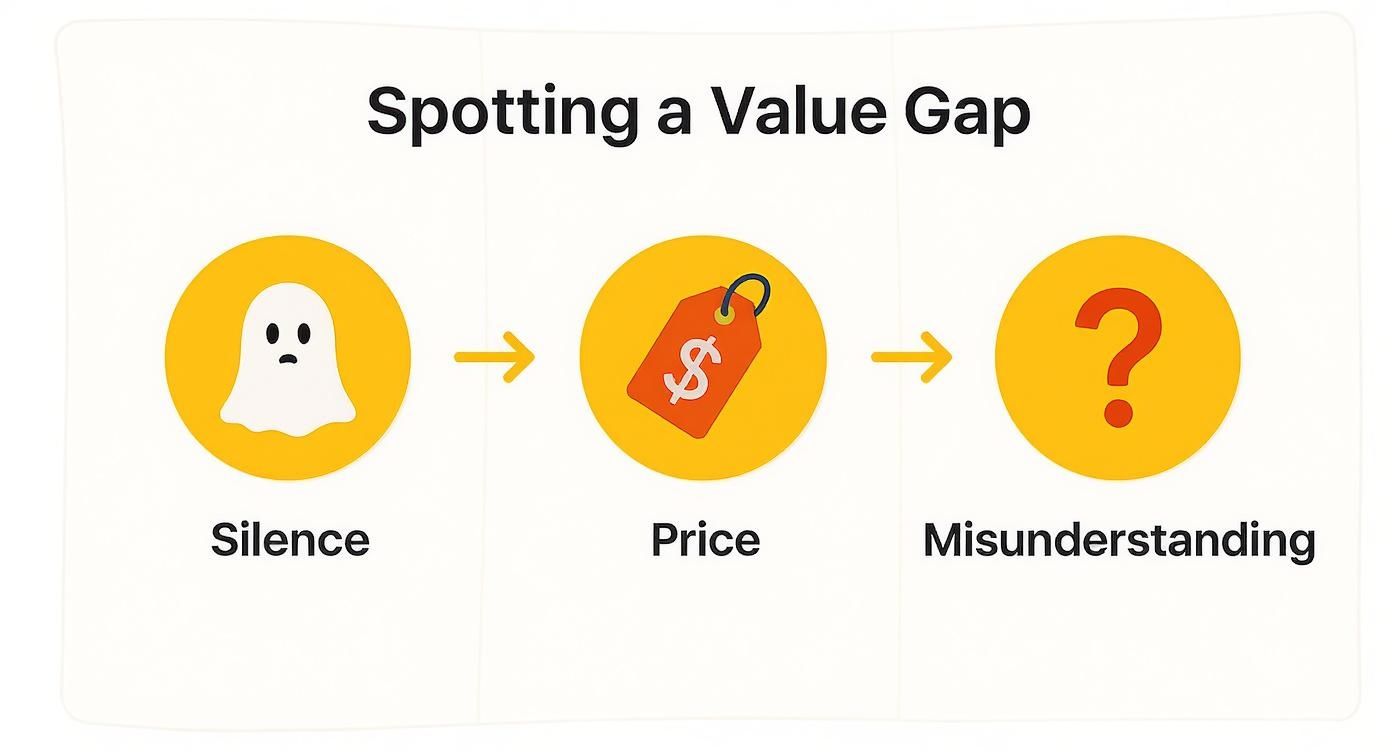ChatGPT Lead Generation: Boost Your Outreach & Results
Learn how to leverage chatgpt lead generation to qualify prospects and scale marketing effectively. Discover proven strategies to drive results.
Struggling to win deals? The value gap is likely the cause. Learn proven strategies to identify and close this gap to boost your sales performance.
TL;DR: The "value gap"—the difference between what you think your solution is worth and what your customer believes it's worth—is the silent killer of promising deals. Closing this gap by focusing on tangible ROI and specific business outcomes is the fastest way to shorten your sales cycle and win more consistently.
Let’s talk about the value gap. Ever had a deal that felt like a sure thing, only to watch it stall out, lose to a competitor, or get ground down into a frustrating price negotiation? The culprit is almost always the value gap.
Simply put, the value gap is the chasm between the solution you think you’re offering and what your customer actually believes it’s worth.

This gap isn't just some minor misunderstanding; it’s a silent deal-killer. It opens up the moment your prospect fails to connect the dots between your solution and their most pressing business priorities.
When they can’t see a clear, tangible return on their investment, their motivation to buy simply evaporates. Why would they fight for a budget or champion your solution internally if they don't truly get the value?
Seeing this disconnect is the first step to fixing it. You can learn more about pinpointing what buyers truly care about by understanding what is intent data and how it reveals their priorities.
Ultimately, closing the value gap is the most direct path to better sales performance and less wasted effort on deals that were never going to close.

So, what exactly is this value gap that sabotages so many deals? It’s more than just a buzzword; it’s a destructive force in your pipeline. Let’s break it down.
Imagine your prospect is on one side of a deep canyon, stuck with a critical business problem. Your solution is on the other side, representing the promised land. Your job as a seller is to build a solid bridge that connects the two.
The value gap is like building that bridge with missing planks. From your side, it looks pretty good. You see the structure, you know it’s sound. But from the prospect's perspective? They see a risky, incomplete path. They see a chasm between where they are today and the future you’re describing, and they’re not about to take a leap of faith.
This hesitation has almost nothing to do with your product's feature list or a competitor’s slick demo. It boils down to a fundamental failure of connection.
The value gap opens up the moment a customer can't draw a straight line from your solution to their most pressing priorities. Sure, they might understand what your product does on paper, but they haven’t internalized what it will do for them in a tangible, measurable way.
This disconnect is the silent obstacle that derails even the most promising sales cycles. It’s the reason prospects ghost you, fixate on price, or kick the can down the road indefinitely. Deals stuck in this limbo are a classic symptom of a pipeline clogged by unresolved value gaps. You can learn more about managing these holdups by exploring the different sales pipeline stages and spotting where deals most often stall.
A value gap isn't just a sales problem; it's a communication breakdown. It means the perceived risk of making a change still outweighs the perceived reward of your solution.
When this happens, all your deal momentum evaporates. The internal champion who was once your biggest advocate now lacks the conviction to fight for your solution internally. Without a crystal-clear vision of the return on their investment, your deal is dead in the water—just waiting for a competitor to come along and build a better bridge.
Value gaps don't just pop into existence. They're usually the slow-burning result of small missteps, bad assumptions, and a failure to connect on both sides of the table. For sellers, the problem often starts with shallow, checklist-style discovery. When you don't dig deep, you end up with generic messaging that sails right past the prospect.
You start talking about features, not outcomes. That's the classic sign of a looming value gap.
The customer hears all about what your product does, but they’re left completely on their own to figure out what it will do for them. This disconnect gets even wider when you fail to paint a clear picture of long-term ROI. Without a strong business case, the perceived value of your solution plummets, making it dangerously easy for the prospect to choose a cheaper competitor or just stick with the status quo.
But let's be fair, it isn't always the salesperson's fault. Prospects often bring their own baggage to the conversation that can create or widen the value gap. This could be anything from preconceived ideas about your solution to a genuine blind spot about the full scope of their own problem.
Internal politics can be a huge factor, too. Sometimes a key decision-maker has a personal agenda that clashes with the logical, data-backed value you're presenting. You might also find the customer doesn't fully grasp their own needs, making it impossible for them to appreciate a solution built to solve them.
You can get in front of this with rock-solid upfront research. A great way to do this is by learning how to use public filings for account research and strategic value selling.
This isn't just a B2B sales problem. Look at the music industry. Streaming makes up about 84% of total revenue. But because so much listening is passive and driven by algorithms, paid streaming only accounts for 23% of actual consumption. This creates a massive value gap between how much music is used and how little creators are compensated. You can see the full research on how this value gap impacts creators.
The table below breaks down some of the most common reasons value gaps form and the damage they can do to your deals.
| Cause of Value Gap | Impact on the Deal |
|---|---|
| Shallow Discovery | Leads to generic pitches that don't resonate with specific pains. |
| Feature-Dumping | Forces the buyer to connect the dots between features and their own business outcomes. |
| No Clear ROI | Makes it hard to justify the price and defend against cheaper alternatives. |
| Ignoring Internal Politics | You lose to a hidden agenda you never saw coming. |
| Prospect Misunderstands the Problem | They can't see the value in a solution for a problem they don't fully recognize. |
| Single-Threading | Your entire deal rests on one person's perception of value, which is incredibly risky. |
Recognizing these destructive patterns—whether they start with you or your customer—is the absolute first step. Once you can spot them, you can start proactively stopping them from blowing up your deals.
Think of a value gap as smoke before a fire. Spot it early, and you can act before the entire deal goes up in flames. The trick is to stop listening for what you want to hear and start tuning into the subtle cues that signal a real disconnect.
These warning signs often masquerade as standard sales hurdles, but they point to a much deeper problem with how your prospect sees your solution.
The most glaring red flag? When a once-engaged prospect goes completely dark. If they stop replying to emails or keep pushing back calls, it's not just a "busy schedule." It's a clear symptom that their perceived value is cratering. Another classic sign is an obsessive focus on price. When a prospect fixates on cost above all else, it's because you haven’t given them a compelling reason to focus on anything else.
The questions a prospect asks—or more importantly, doesn't ask—are incredibly telling. If their questions are superficial or show they've completely missed the core benefit of your solution, a value gap is opening up right in front of you. This isn't just a standard objection; it's a sign they haven't connected the dots between your product and their actual problems.
A value gap isn't just a B2B sales issue. In the music industry, it refers to the massive discrepancy between the revenue streaming platforms generate and what artists actually receive. Market consolidation and platform mechanisms have created a system that devalues creativity and redirects income away from independent creators. Learn more about how this value gap impacts the music industry.
Proactive listening is your best diagnostic tool here. Keep a sharp ear out for these common warning signs:
These aren't just obstacles to overcome; they are critical signals that demand your attention. To get better at reading the tea leaves, check out our guide on what is a buying signal and how to respond effectively.
Catching these signs early gives you a fighting chance to recalibrate your approach, re-establish the value, and pull the deal back from the brink.
Spotting a value gap is one thing. Closing it is what actually saves the deal. This is where you have to deliberately shift from talking about features to showing tangible business outcomes. It’s all about making the connection between your solution and the prospect's success so clear that it’s impossible to ignore.
The trick is to reframe the entire conversation. Instead of focusing on what your product is, every interaction needs to be about what it does for their specific situation. This turns your pitch into a rock-solid business case.
This visual breaks down the common warning signs—radio silence, price objections, and crossed wires—that signal a value gap is opening up.

Catching these signals early gives you a fighting chance to rebuild that perceived value before the deal grinds to a halt.
One of the most powerful ways to bridge the value gap is to clearly demonstrate the return on investment (ROI) your solution delivers. Knowing how to calculate marketing ROI and applying those same principles to your sales conversations can turn a "nice-to-have" product into an essential business investment. Vague claims like "improved efficiency" just don't cut it anymore.
Instead, you need to build a compelling ROI story using the prospect’s own metrics. This usually involves a few key steps:
The concept of a value gap isn't just for B2B sales. Take the US music industry, for example. Premium streaming subscriptions shot up to 105.3 million, but the wholesale revenue from it only grew by a tiny 0.9%. That massive disconnect shows a structural failure in turning high user engagement into fair compensation for artists. You can read more about this structural value gap in the music industry.
By focusing on these value-based strategies, you build a bridge of logic and trust that makes your solution the obvious choice. You stop selling a product and start selling a guaranteed positive outcome.
Ultimately, closing the value gap isn't about rescuing one deal at a time. It’s about fundamentally changing how your entire sales organization operates.
This is a big shift. You have to move from a product-focused pitch to a value-centric conversation. That needs to become the core of your sales methodology, not just a tactic you pull out for struggling accounts.
This kind of transformation always starts with leadership. Sales leaders have to train their teams to be relentlessly curious about what the customer actually values. Every discovery call, every demo, and every proposal should be built around answering one question: "How does this directly solve our customer's most critical business problem?"
When you make that question the heart of your process, you build a powerful competitive edge that goes way beyond features and price.
Getting these strategies into your team’s DNA requires a deliberate, ongoing effort. It’s about creating a culture where identifying and closing the value gap is everyone’s primary job.
This means arming your team with the right tools, training, and reinforcement to make "value" the default language of every single sales conversation.
This operational shift has some pretty profound benefits:
Putting sales enablement best practices into action can seriously empower your team to articulate and demonstrate value, making sure it stays at the center of every interaction.
Your goal isn't just to sell a product; it's to become an indispensable partner in your customer's success. You get there by consistently proving that you understand their challenges better than anyone else and can deliver a clear, measurable return on their investment.
When your entire sales process is engineered to close the value gap, you don't just win more deals—you build a resilient business that thrives on creating undeniable customer value.
Here are answers to some of the most common questions about identifying and closing the value gap.
Think of it this way: a sales objection is a symptom, while the value gap is the underlying disease. An objection is the specific reason a prospect gives for stalling ("it's too expensive"). The value gap is the real reason they feel that way—they don't see enough worth in your solution to justify the cost or effort. A strong value proposition often prevents objections from ever coming up.
Listen for disconnects. Early warning signs include vague or superficial questions from the prospect, a heavy focus on price before value has been established, or an inability to articulate the business problem they're trying to solve. If they can't clearly state the pain, they won't appreciate the value of your solution.
Quantify the outcome. Move the conversation away from features and focus on tangible ROI. Work with the prospect to put a dollar amount on their current problem (e.g., "This inefficiency is costing you $X per quarter"). Then, present your solution as the direct path to capturing that value. This reframes the purchase from an expense to an investment.
Absolutely. A prospect can be impressed by your demo and still not buy. This happens when they see the product as a "nice-to-have" tool rather than an essential solution to a critical business priority. Liking the product isn't enough; they must believe it's indispensable for achieving their goals.
Instead of spending hours on manual research, let Salesmotion automatically uncover the critical insights you need to build value from the very first touchpoint. See how our AI-powered account intelligence platform can help you close the value gap and accelerate your deals by visiting https://salesmotion.io.
Learn how to leverage chatgpt lead generation to qualify prospects and scale marketing effectively. Discover proven strategies to drive results.
Discover how smart lead routing can stop revenue leaks and boost conversions. Learn proven strategies to automate and optimize your sales process.
Discover proven B2B prospecting strategies that build pipeline and drive sales. Learn how to find high-value leads and master modern outreach.